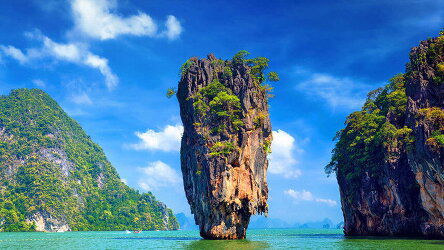A Taste of Vietnam - Halong Bay to the Mekong Delta
Overview
Itinerary
Arrive in Vietnam's capital, Hanoi, famous for its rich culture, bustling life and colonial influences. Its small lakes, busy streets and secluded alleyways are all waiting to be explored.
For those arriving on time, our tour leader plans to meet you in the hotel reception at 6pm for the welcome meeting and for those that wish, there is the chance to go out on a street food tour. There are no other activities planned today, so you're free to arrive in Hanoi at any time. If you'd like an airport transfer today, you'll need to arrive into Noi Bai International Airport (HAN), which is only a 45-minute drive from the hotel. Should you miss the welcome meeting, our tour leader will leave a note at the front desk to inform you of any essential information.
This evening, we'll embark on a street food tour, exploring the narrow lanes of the Old Quarter. Focusing on Dinh Liet and Ta Hien Street, we'll stop by several vendors to try some local delicacies. Banh Goi is a Vietnamese crispy dumpling and makes a perfect street snack with its rice paper outer stuffed with minced meat and soft noodles. Another Hanoi delicacy is Bun Cha - seasoned pork meatballs served with rice noodles and fresh herbs. Stay: Flower Garden Hotel (Premium) (D)
We start this morning like the city's locals - with a steaming bowl of the ubiquitous Pho. Pronounced 'Fuh', this beef and noodle soup is Vietnam's national dish and each region has its own take - with the herbs, noodles and broth differing from north to south. In Hanoi, pho is prepared the night before in giant containers, with beef bones, oxtails, herbs and spices simmering in a rich broth for up to 14 hours to draw out the maximum amount of flavour. It's then served for breakfast the next morning with thinly sliced beef flank or brisket, flat rice noodles and garnished with fresh herbs. We'll have breakfast at a local pho stall before starting our day. Next up will be an egg coffee (ca phe trung). This concoction is made by beating an egg yolk with condensed milk for about 10 minutes, forming a cake-like batter. This is then poured on top of a steaming espresso.
Filled up and thirsts quenched, we continue to take in some of the capital's main sights. Architecturally styled like a French provincial town with tree-lined boulevards and low-built houses, the city is wonderfully nostalgic. Among the interesting sights are the charming One-Pillar Pagoda, the Temple of Literature and the Presidential Palace. Ho Chi Minh himself, a spartan-living and scholarly man, chose not to live in the Presidential Palace; he preferred instead a simple teak stilt house specially built for him on the grounds.
We'll then cross the Red River and head out of the city to the ancient settlement of Bat Trang. This small village is known for its intricate pottery and is like stepping back in time and offers an insight into what village life was like in the north before it was colonised by the French. Ancient shuttered houses, elegant pagodas and communal halls line the narrow brick lanes which are interspersed by great sprawling Banyan trees. We meet with one of the local residents who gives us some insight into the history here, before teaching us to prepare some local delicacies. We make cha gio, more commonly known as spring rolls, cha la lot (beef-stuffed betel leaves) and thit xien nuong (grilled meat skewers).
From here, we continue by road to Halong Bay. Stay: New Star Ha Long 2 Hotel (Comfortable) (B/L)
One of South East Asia's most spectacular settings, where thousands of limestone islands rise from the jade-green waters of the bay like the scales of some great submerged dragon, Ha Long Bay is a World Heritage site of natural majesty. Ha Long translates as the place where the dragon descends to the sea and local legend tells of a time when this rugged landscape was created by the pounding tail of a mighty dragon as he ran from the mountains into the sea.
This morning, we'll board a charter boat for a cruise amongst its limestone islands, threading our way through a flotilla of boats, junks and wooden sampans as they ply their way across the gentle waters of the bay. The plan is to spend the day sailing through this stunning seascape, stopping off to visit some of the limestone caverns that pepper the landscape and enjoy a delicious lunch on board.
After disembarking later in the afternoon, we will drive to the small town of Ninh Binh. Stay: Van Long Green Hotel (Comfortable) (B/L)
This morning, we head into the countryside to explore the more rural side of Vietnam, and to the source of some of the fantastic ingredients we are sampling. Our day starts with a family learning how to cook the Ninh Binh dish of com chay, literally translated to 'burnt rice'. This crispy rice square is paired with meat, fresh vegetables and secret spices for a thoroughly tasty snack.
Afterwards, we'll head outside the village to learn about the farming techniques and practices that have been used here for hundreds of years and passed down through generations. We'll have an opportunity to help cultivate rice, cut banana leaves, tend to the gardens and generally participate in farm life. We eat on the farm, with a meal prepared from the fresh and local produce we have spent time amongst.
After lunch we take a leisurely bike ride through the lush rice paddies, passing pagodas and through small villages.
After freshening up this evening, we'll proceed to the train station to board the Reunification Express, for our overnight train journey to Dong Hoi.
We plan to stay in 'soft-sleeper' four berth cabins, bunk bed style and bedding is provided. Both Western and Asian style toilets are at the end of each carriage as well as a basin. Our tour leader will allocate beds and will try to keep our group together as far as possible, however, it might be necessary to share with other travellers and passengers of a different gender. Stay: Overnight Train to Dong Hoi (Comfortable) (B/L)
After freshening up and taking breakfast at a local hotel, we drive into the majestic Phong Nha National Park - a UNESCO-listed paradise made up of towering limestone karst landscapes, verdant jungle, vast, cavernous caves, and a network of underground rivers.
We'll board small wooden boats that take us across the placid Son River, winding its way through the lush vegetation and then inside the mouth of Phong Nha Cave. This vast cavern is adorned by huge stalactites and stalagmites cutting through the cave like the teeth of a giant monster, according to local legend.
We have some time exploring the cave before we stop for lunch where we enjoy barbecued river prawns, grilled fish, marinated BBQ pork and freshly prepared Vietnamese salad.
After a leisurely lunch there may be sometime to swim in the river before we move on the incredible Paradise Cave. This cave stretches some 7km deep into the limestone rock , with the first kilometre stretch made accessible boardwalks and lighting. The cave is a testament to the raw power of nature, as it continues to shape and change as water trickles its way through the rocks and the lights illuminate the multiple colours on display.
Later we drive back to Dong Hoi where our evening is at leisure. Stay: Muong Thanh Hoilday Quang Binh (Comfortable) (B/L)
We make our way this morning to the iconic 17th parallel, which formed the border between North and South Vietnam between 1954 after the First Indochina War, until 1976 after the reunification of Vietnam. The De-Militarised Zone formed an approximate 10-kilometre buffer stretching from the Laotian border through to the Vietnamese coastline.
We explore some of the areas found along the DMZ including Vinh Moc - a village that relocated its entire population underground, into an amazing network of tunnels and caverns that snake their way out to a beach on the South China Sea. We also visit the Quang Tri Citadel, an ancient walled Imperial City that saw huge amounts of fighting during the war and as such its structure has been peppered with bullet holes.
From the DMZ, we'll cross the Ben Hai River and continue onto the ancient city of Hue, where this evening we will take part in a 10-course Royal Banquet. Hue's Nguyen dynasty ruled over the imperial city for over a century and developed a whole series of culinary traditions, from ingredients through to preparation and presentation. This evening we sample several of the dishes in the traditional way, elaborately presented in animal form such as a phoenix or an elephant. Our dinner is accompanied by royal folk music and we will get to try such dishes as nem cong (peacock starter), Tom ngu thuyen ron (shrimp in passionfruit sauce) and chuoi ngu & banh phu the (stuffed mung bean cake served with banana). Stay: Thanh Lich 2 Hotel (Comfortable) (B/D)
Once the capital of Vietnam and an inspiration for poets and artists alike for centuries, Hue is divided by the waters of the Perfume River, which separate the city's 19th-century citadel from the suburbs that radiate from the eastern shore. Even today, its easy air of leisurely ambience makes it one of the most engaging cities in the country to explore and this morning we head out to the imposing citadel. Built by the Nguyen dynasty (Vietnam's ruling emperors from the early 1800s to 1945), the citadel still dominates the left bank of the Perfumed River. Its formal moats and impressive ramparts were constructed to be an exact copy of the Forbidden City in Beijing, and whilst much of the inner city suffered badly during the heavy bombardments of the Tet Offensive in 1968, the huge outer walls and the West Wing remain an eloquent reminder of the palace's former glory.
This morning, we have time to explore the imposing Citadel before visiting a nearby family to learn to make a tasty snack that is popular during TET (Vietnamese New Year) celebrations - green bean cake. Later in the morning, we'll visit the Thien Mu Pagoda and the Tu Duc Tomb, a mausoleum dedicated to the longest-reigning emperor of the Nguyen dynasty, said to have over 100 wives and concubines.
Then, this evening, we'll drive outside of the city limits to dine with a local family. We'll be welcomed as friends and have the opportunity to share stories and experiences over a variety of flavoursome home-cooked meals including va tron (Hue fig salad) banh beo (water fern cakes) and bun bo (a spicy beef and pork noodle soup). Stay: Thanh Lich 2 Hotel (Comfortable) (B/D)
A coastal drive awaits this morning as we drive towards the Truong Son Mountains and the lofty heights of the Hai Van (Sea Cloud) Pass. This scenic region once marked the boundary between Vietnam and the Champa Kingdom to the south and as we reach the pass itself the views before us are simply spectacular. After a short stop at the pass, we drive downhill towards the UNESCO-awarded fishing port of Hoi An, accompanied by stunning panoramas of mountains, islands and ocean.
Before arriving in Hoi An, we visit Tra Que Herb Village, a quaint area of lush fertile ground served by the Thu Bon River Delta where over 150 farmers tend to their vegetable patches. We will meet some of the farmers and learn about some of the produce grown here and how the crops are helped along not with pesticides but with local algae found in a nearby lagoon. We will get the opportunity to relax here with a foot soak made from a solution packed full of the herbs grown here.
For lunch, we stop for banh mi, once-lauded by Anthony Bourdain as a 'symphony in a sandwich'. The banh mi is one of Asia's best examples of fusion cuisine - taking the humble French baguette and then stuffing it chock-full of fresh and flavoursome Vietnamese ingredients. A traditional banh mi would usually contain pate, beef or pork sausage, coriander, chillies, pickled carrots and finished with creamy mayonnaise. We will eat this street-side before continuing on our walking tour of Hoi An, taking in the incredible architecture of buildings like the Japanese Bridge and the Chinese Meeting Hall. The streets are lined with lanterns that glow in a haze of technicolour as the sun starts to set and day turns to night.
This evening has been left free to take in the wonderful evening atmosphere of the town or to independently try one of the many excellent eateries here. Stay: Thanh Binh Central Hotel (Premium) (B/L)
The historic, merchant town of Hoi An had become one of the busiest international trading ports of Southeast Asia by the 17th and 18th centuries. First colonised by the Portuguese in the 16th century it still retains its medieval charm today, with many of its old buildings superbly preserved. The day has been left free to explore at leisure. You may choose to visit the Japanese Bridge or some of the Chinese temples and meeting halls in the Old Town. There are many shops, bars and restaurants in this charming town and it is a great place to buy souvenirs, have clothing tailored or simply watch the world go by in a riverside cafe. You may wish to take an optional excursion out to the site of the My Lai village massacre memorial. The massacre was a significant turning point in the American War and the horrific story is told through a very emotive exhibition of photography.
Another option would be to take a fishing trip out to the Thu Bon River Delta, where we learn how to fish using a traditional cast net. Travelling out by boat we meet local fishermen and try our hand at cast net fishing as well as trying the bamboo winches used to haul in the huge drop nets from the river. We also have a chance to go out in a Vietnamese 'basket boat' - a circular boat constructed from bamboo that takes a little practice to row! Stay: Thanh Binh Central Hotel (Premium) (B)
After a short drive to Danang Airport, we fly to Ho Chi Minh City, from where we drive further south to Ben Tre in the Mekong Delta. Surrounded by lush and fertile land the area is home to a patchwork of cottage industries, with the villagers all plying their trade from this vital life source - either from growing produce on its land, fishing its vast waterways or making things from the local resources. We take a traditional sampan through the narrow waterways lined with swaying coconut palms, where we visit a series of villagers, all making their own delicacies from the produce around them.
We can try baked potato cakes, Vietnamese doughnuts or suong sam - a Vietnamese jelly. We also spend some time in the delta cycling alongside palm-fringed canals, an excellent opportunity to take in daily life in this thriving region of Vietnam.
This evening, we help prepare our meal alongside our hosts, making such dishes as ca loc nuong trui (grilled snakehead fish), banh xeo (rice pancakes) and banh la mit (jackfruit leaf cake). Stay: Ut Trinh Homestay - Ben Tre () (B/L/D)
We spend a further morning exploring the delta by boat, visiting one of the bustling local markets where fish, vegetables, exotic fruits and drinks are sold. We'll also likely see an array of colourful exotic fruits not familiar to us, such as rambutan, mangosteen, dragon fruit and jack fruit - the heaviest fruit in the world. We will buy some ingredients at the market which we then take to a local house, to learn how to make a selection of snacks that are ubiquitous to this corner of Vietnam.
After lunch, we drive back to Ho Chi Minh City. Still commonly referred to by locals as 'Saigon', the city is the largest in Vietnam and the country's commercial hub. You will find an eclectic mix of the traditional and the new, where pagodas and markets compete alongside the trappings of Vietnam's newly discovered entrepreneurial spirit.
Later this afternoon we embark on a street food tour along some of Old Saigon's bustling moped-laden streets. Over 86% of households in Vietnam own a motorbike, and Ho Chi Minh City's streets are thought to be the most densely- packed in the world for scooters. So much so, the Vietnamese have even designed their own way to cross the road, walking slowly but consistently so the motorcyclists can predict your path and then either go in front or behind you. It's a little unnerving, but sometimes necessary!
On the food tour, we talk to several stall vendors and will be able to try different food such as fried quail eggs with tamarind, nam vang noodle soup, crispy sweet potato balls and even avocado ice cream. Stay: Alagon Central Hotel (Comfortable) (B/L/D)
We set off this morning to the International Barista School, an institution providing local students with an international accreditation in the art of coffee making. We spend the morning here with one of the expert baristas, who will be explaining the importance of coffee in Vietnam, and the story of how Vietnam grew to become the second-largest exporter of coffee in the world. We learn about the art of growing, roasting and grinding the bean, and how different notes and acidities of the bean are created and detected. We also learn to brew and press the coffee, and of course, finish off with some latte art.
Later this afternoon, we'll set off for a walking tour of the city. The tour will take in some of the central sights of the city, including the Opera House (formerly South Vietnam National Assembly), Hotel de Ville, Notre Dame Cathedral and the impressive French-style edifice that is the GPO building.
The rest of this evening has been left free as there are a wide variety of excellent restaurants in Ho Chi Minh City to choose from. Stay: Alagon Central Hotel (Comfortable) (B)
The trip ends after breakfast at our hotel in Ho Chi Minh City.
There are no activities planned today, so you are free to depart from Ho Chi Minh City at any time. If your flight is departing later in the day, luggage storage facilities are available at our hotel. If you would like to receive a complimentary airport transfer today, you'll need to depart from Tan Son Nhat International Airport (SGN), which is 45 minutes from the hotel. (B)
Arrive in Vietnam's capital, Hanoi, famous for its rich culture, bustling life and colonial influences. Its small lakes, busy streets and secluded alleyways are all waiting to be explored.
For those arriving on time, our tour leader plans to meet you in the hotel reception at 6pm for the welcome meeting and for those that wish, there is the chance to go out on a street food tour. There are no other activities planned today, so you're free to arrive in Hanoi at any time. If you'd like an airport transfer today, you'll need to arrive into Noi Bai International Airport (HAN), which is only a 45-minute drive from the hotel. Should you miss the welcome meeting, our tour leader will leave a note at the front desk to inform you of any essential information.
This evening, we'll embark on a street food tour, exploring the narrow lanes of the Old Quarter. Focusing on Dinh Liet and Ta Hien Street, we'll stop by several vendors to try some local delicacies. Banh Goi is a Vietnamese crispy dumpling and makes a perfect street snack with its rice paper outer stuffed with minced meat and soft noodles. Another Hanoi delicacy is Bun Cha - seasoned pork meatballs served with rice noodles and fresh herbs. Stay: Flower Garden Hotel (Premium) (D)
We start this morning like the city's locals - with a steaming bowl of the ubiquitous Pho. Pronounced 'Fuh', this beef and noodle soup is Vietnam's national dish and each region has its own take - with the herbs, noodles and broth differing from north to south. In Hanoi, pho is prepared the night before in giant containers, with beef bones, oxtails, herbs and spices simmering in a rich broth for up to 14 hours to draw out the maximum amount of flavour. It's then served for breakfast the next morning with thinly sliced beef flank or brisket, flat rice noodles and garnished with fresh herbs. We'll have breakfast at a local pho stall before starting our day. Next up will be an egg coffee (ca phe trung). This concoction is made by beating an egg yolk with condensed milk for about 10 minutes, forming a cake-like batter. This is then poured on top of a steaming espresso.
Filled up and thirsts quenched, we continue to take in some of the capital's main sights. Architecturally styled like a French provincial town with tree-lined boulevards and low-built houses, the city is wonderfully nostalgic. Among the interesting sights are the charming One-Pillar Pagoda, the Temple of Literature and the Presidential Palace. Ho Chi Minh himself, a spartan-living and scholarly man, chose not to live in the Presidential Palace; he preferred instead a simple teak stilt house specially built for him on the grounds.
We'll then cross the Red River and head out of the city to the ancient settlement of Bat Trang. This small village is known for its intricate pottery and is like stepping back in time and offers an insight into what village life was like in the north before it was colonised by the French. Ancient shuttered houses, elegant pagodas and communal halls line the narrow brick lanes which are interspersed by great sprawling Banyan trees. We meet with one of the local residents who gives us some insight into the history here, before teaching us to prepare some local delicacies. We make cha gio, more commonly known as spring rolls, cha la lot (beef-stuffed betel leaves) and thit xien nuong (grilled meat skewers).
From here, we continue by road to Halong Bay. Stay: New Star Ha Long 2 Hotel (Comfortable) (B/L)
One of South East Asia's most spectacular settings, where thousands of limestone islands rise from the jade-green waters of the bay like the scales of some great submerged dragon, Ha Long Bay is a World Heritage site of natural majesty. Ha Long translates as the place where the dragon descends to the sea and local legend tells of a time when this rugged landscape was created by the pounding tail of a mighty dragon as he ran from the mountains into the sea.
This morning, we'll board a charter boat for a cruise amongst its limestone islands, threading our way through a flotilla of boats, junks and wooden sampans as they ply their way across the gentle waters of the bay. The plan is to spend the day sailing through this stunning seascape, stopping off to visit some of the limestone caverns that pepper the landscape and enjoy a delicious lunch on board.
After disembarking later in the afternoon, we will drive to the small town of Ninh Binh. Stay: Van Long Green Hotel (Comfortable) (B/L)
This morning, we head into the countryside to explore the more rural side of Vietnam, and to the source of some of the fantastic ingredients we are sampling. Our day starts with a family learning how to cook the Ninh Binh dish of com chay, literally translated to 'burnt rice'. This crispy rice square is paired with meat, fresh vegetables and secret spices for a thoroughly tasty snack.
Afterwards, we'll head outside the village to learn about the farming techniques and practices that have been used here for hundreds of years and passed down through generations. We'll have an opportunity to help cultivate rice, cut banana leaves, tend to the gardens and generally participate in farm life. We eat on the farm, with a meal prepared from the fresh and local produce we have spent time amongst.
After lunch we take a leisurely bike ride through the lush rice paddies, passing pagodas and through small villages.
After freshening up this evening, we'll proceed to the train station to board the Reunification Express, for our overnight train journey to Dong Hoi.
We plan to stay in 'soft-sleeper' four berth cabins, bunk bed style and bedding is provided. Both Western and Asian style toilets are at the end of each carriage as well as a basin. Our tour leader will allocate beds and will try to keep our group together as far as possible, however, it might be necessary to share with other travellers and passengers of a different gender. Stay: Overnight Train to Dong Hoi (Comfortable) (B/L)
After freshening up and taking breakfast at a local hotel, we drive into the majestic Phong Nha National Park - a UNESCO-listed paradise made up of towering limestone karst landscapes, verdant jungle, vast, cavernous caves, and a network of underground rivers.
We'll board small wooden boats that take us across the placid Son River, winding its way through the lush vegetation and then inside the mouth of Phong Nha Cave. This vast cavern is adorned by huge stalactites and stalagmites cutting through the cave like the teeth of a giant monster, according to local legend.
We have some time exploring the cave before we stop for lunch where we enjoy barbecued river prawns, grilled fish, marinated BBQ pork and freshly prepared Vietnamese salad.
After a leisurely lunch there may be sometime to swim in the river before we move on the incredible Paradise Cave. This cave stretches some 7km deep into the limestone rock , with the first kilometre stretch made accessible boardwalks and lighting. The cave is a testament to the raw power of nature, as it continues to shape and change as water trickles its way through the rocks and the lights illuminate the multiple colours on display.
Later we drive back to Dong Hoi where our evening is at leisure. Stay: Muong Thanh Hoilday Quang Binh (Comfortable) (B/L)
We make our way this morning to the iconic 17th parallel, which formed the border between North and South Vietnam between 1954 after the First Indochina War, until 1976 after the reunification of Vietnam. The De-Militarised Zone formed an approximate 10-kilometre buffer stretching from the Laotian border through to the Vietnamese coastline.
We explore some of the areas found along the DMZ including Vinh Moc - a village that relocated its entire population underground, into an amazing network of tunnels and caverns that snake their way out to a beach on the South China Sea. We also visit the Quang Tri Citadel, an ancient walled Imperial City that saw huge amounts of fighting during the war and as such its structure has been peppered with bullet holes.
From the DMZ, we'll cross the Ben Hai River and continue onto the ancient city of Hue, where this evening we will take part in a 10-course Royal Banquet. Hue's Nguyen dynasty ruled over the imperial city for over a century and developed a whole series of culinary traditions, from ingredients through to preparation and presentation. This evening we sample several of the dishes in the traditional way, elaborately presented in animal form such as a phoenix or an elephant. Our dinner is accompanied by royal folk music and we will get to try such dishes as nem cong (peacock starter), Tom ngu thuyen ron (shrimp in passionfruit sauce) and chuoi ngu & banh phu the (stuffed mung bean cake served with banana). Stay: Thanh Lich 2 Hotel (Comfortable) (B/D)
Once the capital of Vietnam and an inspiration for poets and artists alike for centuries, Hue is divided by the waters of the Perfume River, which separate the city's 19th-century citadel from the suburbs that radiate from the eastern shore. Even today, its easy air of leisurely ambience makes it one of the most engaging cities in the country to explore and this morning we head out to the imposing citadel.
Built by the Nguyen dynasty (Vietnam's ruling emperors from the early 1800s to 1945), the citadel still dominates the left bank of the Perfumed River. Its formal moats and impressive ramparts were constructed to be an exact copy of the Forbidden City in Beijing, and whilst much of the inner city suffered badly during the heavy bombardments of the Tet Offensive in 1968, the huge outer walls and the West Wing remain an eloquent reminder of the palace's former glory.
This morning, we have time to explore the imposing Citadel before visiting a nearby family to learn to make a tasty snack that is popular during TET (Vietnamese New Year) celebrations - green bean cake. Later in the morning, we'll visit the Thien Mu Pagoda and the Tu Duc Tomb, a mausoleum dedicated to the longest-reigning emperor of the Nguyen dynasty, said to have over 100 wives and concubines.
Then, this evening, we'll drive outside of the city limits to dine with a local family. We'll be welcomed as friends and have the opportunity to share stories and experiences over a variety of flavoursome home-cooked meals including va tron (Hue fig salad) banh beo (water fern cakes) and bun bo (a spicy beef and pork noodle soup). Stay: Thanh Lich 2 Hotel (Comfortable) (B/D)
A coastal drive awaits this morning as we drive towards the Truong Son Mountains and the lofty heights of the Hai Van (Sea Cloud) Pass. This scenic region once marked the boundary between Vietnam and the Champa Kingdom to the south and as we reach the pass itself the views before us are simply spectacular. After a short stop at the pass, we drive downhill towards the UNESCO-awarded fishing port of Hoi An, accompanied by stunning panoramas of mountains, islands and ocean.
Before arriving in Hoi An, we visit Tra Que Herb Village, a quaint area of lush fertile ground served by the Thu Bon River Delta where over 150 farmers tend to their vegetable patches. We will meet some of the farmers and learn about some of the produce grown here and how the crops are helped along not with pesticides but with local algae found in a nearby lagoon. We will get the opportunity to relax here with a foot soak made from a solution packed full of the herbs grown here.
For lunch, we stop for banh mi, once-lauded by Anthony Bourdain as a 'symphony in a sandwich'. The banh mi is one of Asia's best examples of fusion cuisine - taking the humble French baguette and then stuffing it chock-full of fresh and flavoursome Vietnamese ingredients. A traditional banh mi would usually contain pate, beef or pork sausage, coriander, chillies, pickled carrots and finished with creamy mayonnaise. We will eat this street-side before continuing on our walking tour of Hoi An, taking in the incredible architecture of buildings like the Japanese Bridge and the Chinese Meeting Hall. The streets are lined with lanterns that glow in a haze of technicolour as the sun starts to set and day turns to night.
This evening has been left free to take in the wonderful evening atmosphere of the town or to independently try one of the many excellent eateries here. Stay: Thanh Binh Central Hotel (Premium) (B/L)
The historic, merchant town of Hoi An had become one of the busiest international trading ports of Southeast Asia by the 17th and 18th centuries. First colonised by the Portuguese in the 16th century it still retains its medieval charm today, with many of its old buildings superbly preserved. The day has been left free to explore at leisure. You may choose to visit the Japanese Bridge or some of the Chinese temples and meeting halls in the Old Town.
There are many shops, bars and restaurants in this charming town and it is a great place to buy souvenirs, have clothing tailored or simply watch the world go by in a riverside cafe. You may wish to take an optional excursion out to the site of the My Lai village massacre memorial. The massacre was a significant turning point in the American War and the horrific story is told through a very emotive exhibition of photography.
Another option would be to take a fishing trip out to the Thu Bon River Delta, where we learn how to fish using a traditional cast net. Travelling out by boat we meet local fishermen and try our hand at cast net fishing as well as trying the bamboo winches used to haul in the huge drop nets from the river. We also have a chance to go out in a Vietnamese 'basket boat' - a circular boat constructed from bamboo that takes a little practice to row! Stay: Thanh Binh Central Hotel (Premium) (B)
After a short drive to Danang Airport, we fly to Ho Chi Minh City, from where we drive further south to Ben Tre in the Mekong Delta. Surrounded by lush and fertile land the area is home to a patchwork of cottage industries, with the villagers all plying their trade from this vital life source - either from growing produce on its land, fishing its vast waterways or making things from the local resources. We take a traditional sampan through the narrow waterways lined with swaying coconut palms, where we visit a series of villagers, all making their own delicacies from the produce around them.
We can try baked potato cakes, Vietnamese doughnuts or suong sam - a Vietnamese jelly. We also spend some time in the delta cycling alongside palm-fringed canals, an excellent opportunity to take in daily life in this thriving region of Vietnam.
This evening, we help prepare our meal alongside our hosts, making such dishes as ca loc nuong trui (grilled snakehead fish), banh xeo (rice pancakes) and banh la mit (jackfruit leaf cake). Stay: Ut Trinh Homestay - Ben Tre () (B/L/D)
We spend a further morning exploring the delta by boat, visiting one of the bustling local markets where fish, vegetables, exotic fruits and drinks are sold. We'll also likely see an array of colourful exotic fruits not familiar to us, such as rambutan, mangosteen, dragon fruit and jack fruit - the heaviest fruit in the world. We will buy some ingredients at the market which we then take to a local house, to learn how to make a selection of snacks that are ubiquitous to this corner of Vietnam.
After lunch, we drive back to Ho Chi Minh City. Still commonly referred to by locals as 'Saigon', the city is the largest in Vietnam and the country's commercial hub. You will find an eclectic mix of the traditional and the new, where pagodas and markets compete alongside the trappings of Vietnam's newly discovered entrepreneurial spirit.
Later this afternoon we embark on a street food tour along some of Old Saigon's bustling moped-laden streets. Over 86% of households in Vietnam own a motorbike, and Ho Chi Minh City's streets are thought to be the most densely- packed in the world for scooters. So much so, the Vietnamese have even designed their own way to cross the road, walking slowly but consistently so the motorcyclists can predict your path and then either go in front or behind you. It's a little unnerving, but sometimes necessary!
On the food tour, we talk to several stall vendors and will be able to try different food such as fried quail eggs with tamarind, nam vang noodle soup, crispy sweet potato balls and even avocado ice cream. Stay: Alagon Central Hotel (Comfortable) (B/L/D)
We set off this morning to the International Barista School, an institution providing local students with an international accreditation in the art of coffee making. We spend the morning here with one of the expert baristas, who will be explaining the importance of coffee in Vietnam, and the story of how Vietnam grew to become the second-largest exporter of coffee in the world. We learn about the art of growing, roasting and grinding the bean, and how different notes and acidities of the bean are created and detected. We also learn to brew and press the coffee, and of course, finish off with some latte art.
Later this afternoon, we'll set off for a walking tour of the city. The tour will take in some of the central sights of the city, including the Opera House (formerly South Vietnam National Assembly), Hotel de Ville, Notre Dame Cathedral and the impressive French-style edifice that is the GPO building.
The rest of this evening has been left free as there are a wide variety of excellent restaurants in Ho Chi Minh City to choose from. Stay: Alagon Central Hotel (Comfortable) (B)
The trip ends after breakfast at our hotel in Ho Chi Minh City.
There are no activities planned today, so you are free to depart from Ho Chi Minh City at any time. If your flight is departing later in the day, luggage storage facilities are available at our hotel. If you would like to receive a complimentary airport transfer today, you'll need to depart from Tan Son Nhat International Airport (SGN), which is 45 minutes from the hotel. (B)
Trip Inclusions
- Immerse yourself in Vietnam's superb cuisine and explore its iconic cultural highlights
- A culinary and varied journey with foodie moments everyday that connect with the locals' passion for food
- Enjoy Halong Bay cruise, bustling Hanoi and Saigon, charming Hoi An and ancient imperial Hue
- Moderate pace tours are ideal if you want a holiday which combines exciting activities and experiences with plenty of time to relax and unwind. Typically you'll be active and busy for part of the day but then also have time to rest and recharge your batteries.
- Accommodation, itinerary and inclusions subject to change.
- Price is for land, cruise and internal flights as specified. Flights not specified are not included
- Immerse yourself in Vietnam's superb cuisine and explore its iconic cultural highlights
- A culinary and varied journey with foodie moments everyday that connect with the locals' passion for food
- Enjoy Halong Bay cruise, bustling Hanoi and Saigon, charming Hoi An and ancient imperial Hue
- Moderate pace tours are ideal if you want a holiday which combines exciting activities and experiences with plenty of time to relax and unwind. Typically you'll be active and busy for part of the day but then also have time to rest and recharge your batteries.
- Accommodation, itinerary and inclusions subject to change.
- Price is for land, cruise and internal flights as specified. Flights not specified are not included

Launching in 1981, Explore offer trips from over 130 countries - from classic small group tours. Read more

Explore's leaders are more than just your typical guide. They're your local expert are are passionate about sharing their expertise with you. Read more

The places Explore stay are every bit as important as the sights they visit and the things you do. Read more

Launching in 1981, Explore offer trips from over 130 countries - from classic small group tours. Read more

Explore's leaders are more than just your typical guide. They're your local expert are are passionate about sharing their expertise with you. Read more

The places Explore stay are every bit as important as the sights they visit and the things you do. Read more
Brochure

Explore Small Group Adventures (2025-26)
Brochure

Explore Small Group Adventures (2025-26)
Availability
A definite departure means minimum numbers have been reached for this departure to operate. Your Global Journeys Travel Advisor will check the availability of your departure date when you enquire. Additional savings may apply. We guarantee the lowest price in Australia. T&C’s apply.
Tour & cruises prices are per person. Prices shown have savings applied, are subject to availability and may be withdrawn at any time without notice. Pricing and trip details are correct at this point in time, however are subject to confirmation at the time of booking and are subject to change by Explore. For cruise itineraries, cabin images are sourced from Explore. These should be treated as indicative only. Cabin inclusions, upholsteries and room layout may differ to the image(s) shown depending on the ship selected and your sailing dates.










